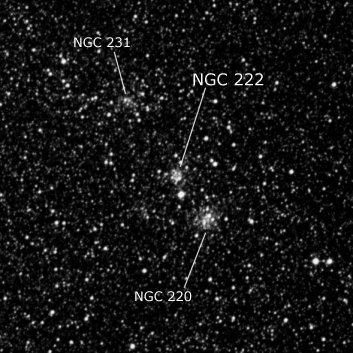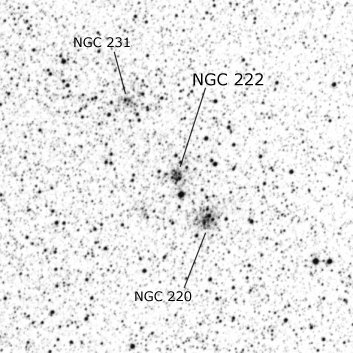NGC/IC Project Restoration Effort
(This is a very very beta version)
NGC222


Basic Information
Location and Magnitude
Right Ascension: 0:40:43.7
Declination: -73:23:9
Constellation: TUC
Visual Magnitude: 12.2
Historic Information
Discoverer: Dunlop
Year of discovery: 1826
Discovery aperture: 9.0
Observational
Summary description: vF, R, 2nd of several
Sub-type: OCL
Corwin's Notes
=====
NGC 222, though usually taken as a smaller, fainter cluster northeast of
NGC 220 (which see), may in fact be a fourth observation of NGC 220 itself.
The other three observations are from Sweeps 482, 625=626 (see my comment
about this sweep in the note for NGC 220), and 745. These have reasonably
accordant positions and descriptions.
NGC 222, on the other hand, was picked up in a single sweep (441 on 11 March
1834), and -- if it is NGC 220 -- has a discordant position (all these
positions are given in the big table). JH notes that this sweep was "below
the pole" in the descriptions of several other objects including NGC 242, 248,
294, 346, and 371. Some of these are also noted as having uncertain positions
in the sweep which adds to my own uncertainty about the observation of NGC
222.
JH made its position 3-4 seconds east and 4 arcmin south of NGC 220. His
description reads simply "vF, R, outlying". I suspect the "outlying" refers
to its position in the SMC.
The faint cluster, ESO 029-SC004, usually carrying the number "NGC 222" is 14
seconds of time east and 1.1 arcminutes north of NGC 220, not a good match at
all for JH's object. That position, and the fact that JH did not record NGC
220 in Sweep 442, leads to my skepticism in accepting the faint cluster as a
genuine discovery by JH. So, I've put my usual question marks on the numbers
in question.
See Archinal and Hynes for a similar discussion, though they eventually accept
the modern identification.
Jenni Kay, in her "A Visual Atlas of the Magellanic Clouds" also accepts the
modern identification of NGC 222, but without question. Using an 8-inch
Schmit-Cassegrain telescope at 110X, she found it "small, round, faint" and
"noticeably fainter [than] its neighbour NGC 220."
-----
In May 2016, I re-reduced JH's observation from the sweep, using the previous
object in the sweep, HD 3719, as a reference star. There is no mistake in
JH's own reduction, but I wondered if a wire error might be possible. He has
wire "2" recorded in the sweep. If he, in fact, used wire "1", then the RA of
NGC 222 would be 00 38 31 (J2000) -- there is nothing in that RA at his
recorded declination (-73 27.9; J2000). If he had actually recorded the
object leaving the field, the RA would be 00 44 01 (also J2000); this position
lands about 2.4 arcminutes southeast of NGC 242 = NGC 241 (which see for
problems of its own). However, NGC 242 is the next object in Sweep 441, so it
is not NGC 222.
JH has a curious note at the end of the sweep: "[Vision?] bad objects faint
and much light cut off by tree tops (to be cut away)". There is another line
at the bottom of the page, but it is mostly illegible in the high-contrast
Herschel Archive reproduction. The "tree tops" comment is fascinating, though
JH notes in CGH under his entry for NGC 242 in this sweep, "(in a sweep below
the pole and ill-seen) the RA is probably also in error."
All of this reinforces the idea that NGC 222 is actually a fourth observation
of NGC 220. So, I've replaced the question mark on this possibility with a
colon, raising the identity to a probability, if not a certainty.
Steve's Notes
=====
NGC 222
18" (7/10/05 - Magellan Observatory, Australia): second and the smallest of three SMC clusters in a string with NGC 220 1.5' SW and NGC 231 2.5' NE. At 228x, appears as a fairly faint, small, round glow of ~30" diameter. A mag 11.5 star lies 30" south.



